Dissertation on Anabolic Steroids and Athlete Cardiovascular Health
VerifiedAdded on 2021/04/21
|28
|7464
|96
Thesis and Dissertation
AI Summary
This dissertation presents a systematic literature review investigating the impact of anabolic steroid (AS) use on the cardiovascular health of athletes. The research explores the effects of AS, a synthetic derivative of testosterone, on various body systems, focusing on the cardiovascular system. The study examines the prevalence of AS use, its associated side effects, and the increased risks of conditions like hypertension and myocardial infarction. The methodology includes a systematic literature review using databases such as PubMed, Science Direct, CINAHL, and Proquest, with specific inclusion and exclusion criteria. The results section highlights the risk of cardiovascular effects due to AAS. The study's aim is to evaluate the adverse effects of AS use on the cardiac health of athletes. The research also identifies the cause behind cardiovascular effects associated with the use of AS among athletes, assesses and describes different types of cardiovascular abnormalities caused due to the use of AS drugs, and suggests ways to curb the use of AS drugs among young athletes. The findings suggest that AS use can lead to ventricular dysfunction, reduced systolic and diastolic function, and accelerated coronary atherosclerosis, emphasizing the need for awareness and further research.

Running head: DISSERTATION
Dissertation
Name of student:
Name of university:
Author note:
Dissertation
Name of student:
Name of university:
Author note:
Paraphrase This Document
Need a fresh take? Get an instant paraphrase of this document with our AI Paraphraser
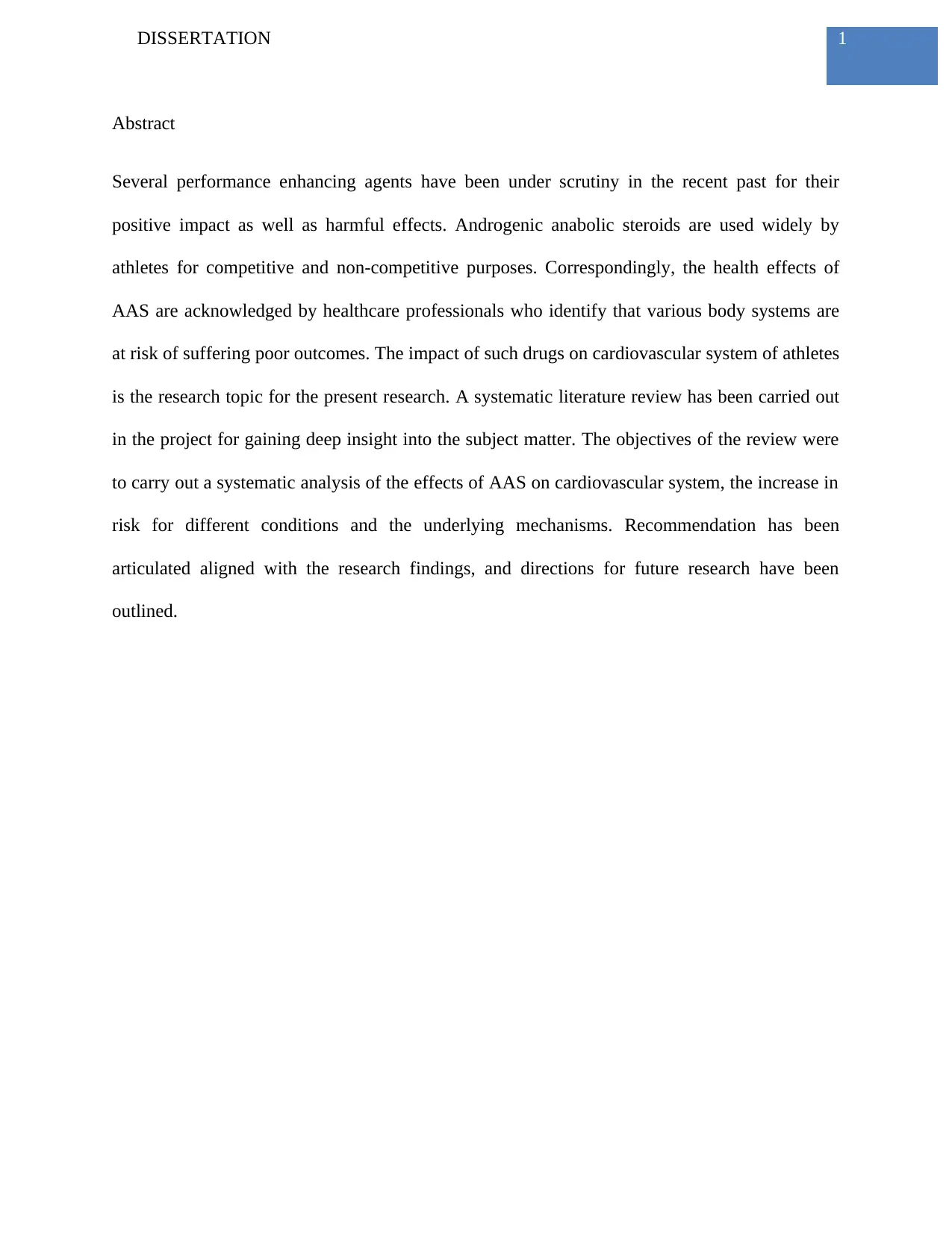
1DISSERTATION
Abstract
Several performance enhancing agents have been under scrutiny in the recent past for their
positive impact as well as harmful effects. Androgenic anabolic steroids are used widely by
athletes for competitive and non-competitive purposes. Correspondingly, the health effects of
AAS are acknowledged by healthcare professionals who identify that various body systems are
at risk of suffering poor outcomes. The impact of such drugs on cardiovascular system of athletes
is the research topic for the present research. A systematic literature review has been carried out
in the project for gaining deep insight into the subject matter. The objectives of the review were
to carry out a systematic analysis of the effects of AAS on cardiovascular system, the increase in
risk for different conditions and the underlying mechanisms. Recommendation has been
articulated aligned with the research findings, and directions for future research have been
outlined.
Abstract
Several performance enhancing agents have been under scrutiny in the recent past for their
positive impact as well as harmful effects. Androgenic anabolic steroids are used widely by
athletes for competitive and non-competitive purposes. Correspondingly, the health effects of
AAS are acknowledged by healthcare professionals who identify that various body systems are
at risk of suffering poor outcomes. The impact of such drugs on cardiovascular system of athletes
is the research topic for the present research. A systematic literature review has been carried out
in the project for gaining deep insight into the subject matter. The objectives of the review were
to carry out a systematic analysis of the effects of AAS on cardiovascular system, the increase in
risk for different conditions and the underlying mechanisms. Recommendation has been
articulated aligned with the research findings, and directions for future research have been
outlined.
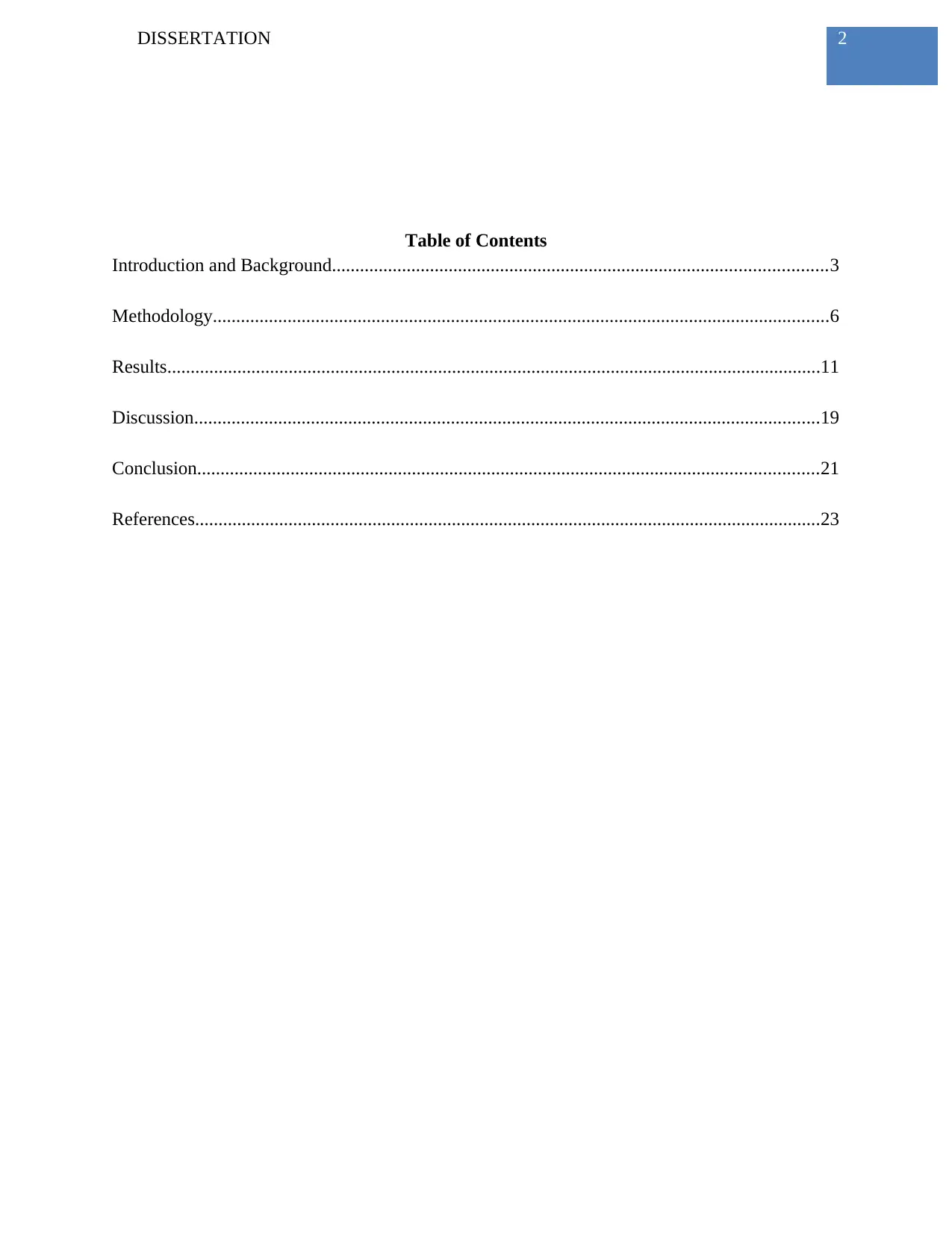
2DISSERTATION
Table of Contents
Introduction and Background..........................................................................................................3
Methodology....................................................................................................................................6
Results............................................................................................................................................11
Discussion......................................................................................................................................19
Conclusion.....................................................................................................................................21
References......................................................................................................................................23
Table of Contents
Introduction and Background..........................................................................................................3
Methodology....................................................................................................................................6
Results............................................................................................................................................11
Discussion......................................................................................................................................19
Conclusion.....................................................................................................................................21
References......................................................................................................................................23
⊘ This is a preview!⊘
Do you want full access?
Subscribe today to unlock all pages.

Trusted by 1+ million students worldwide
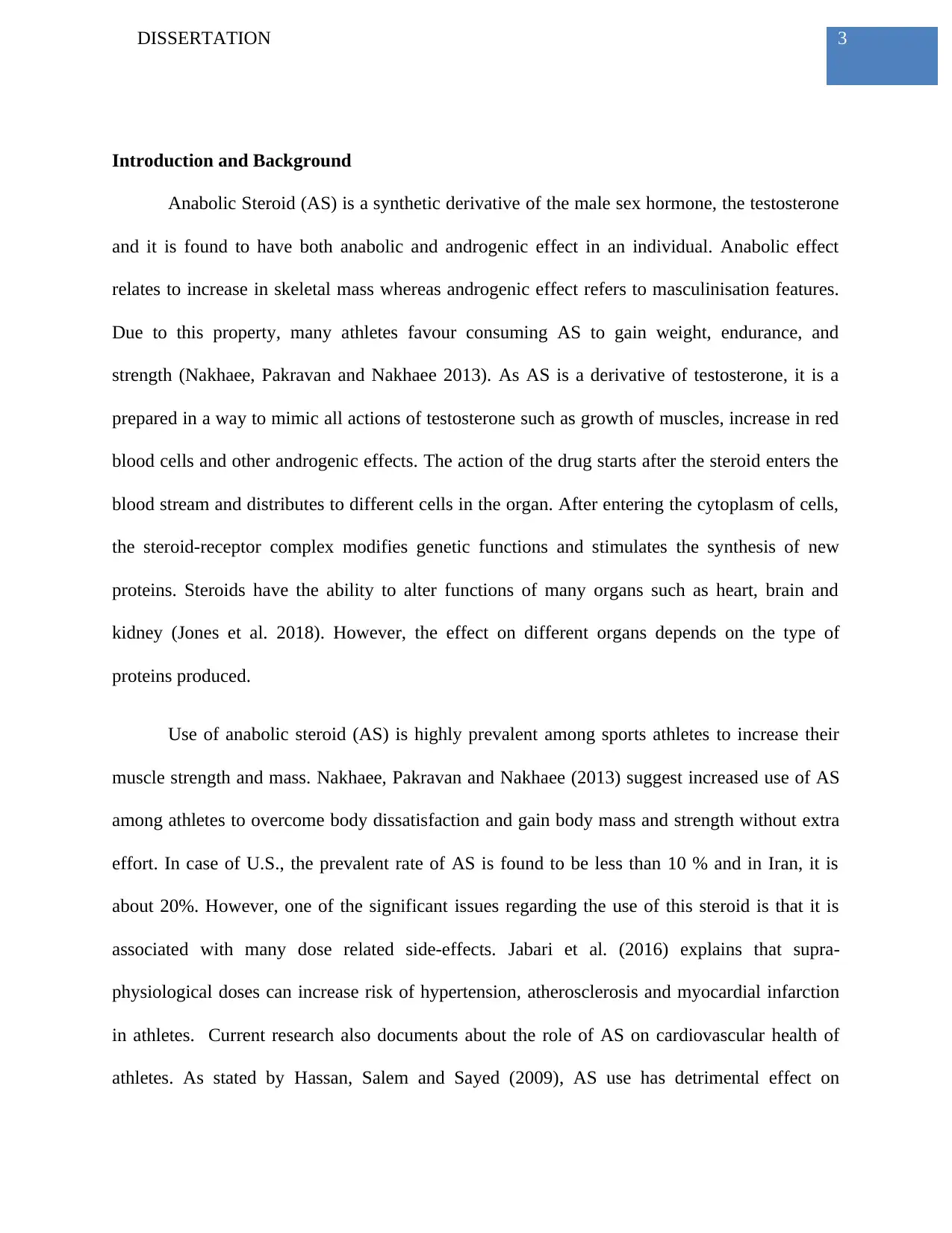
3DISSERTATION
Introduction and Background
Anabolic Steroid (AS) is a synthetic derivative of the male sex hormone, the testosterone
and it is found to have both anabolic and androgenic effect in an individual. Anabolic effect
relates to increase in skeletal mass whereas androgenic effect refers to masculinisation features.
Due to this property, many athletes favour consuming AS to gain weight, endurance, and
strength (Nakhaee, Pakravan and Nakhaee 2013). As AS is a derivative of testosterone, it is a
prepared in a way to mimic all actions of testosterone such as growth of muscles, increase in red
blood cells and other androgenic effects. The action of the drug starts after the steroid enters the
blood stream and distributes to different cells in the organ. After entering the cytoplasm of cells,
the steroid-receptor complex modifies genetic functions and stimulates the synthesis of new
proteins. Steroids have the ability to alter functions of many organs such as heart, brain and
kidney (Jones et al. 2018). However, the effect on different organs depends on the type of
proteins produced.
Use of anabolic steroid (AS) is highly prevalent among sports athletes to increase their
muscle strength and mass. Nakhaee, Pakravan and Nakhaee (2013) suggest increased use of AS
among athletes to overcome body dissatisfaction and gain body mass and strength without extra
effort. In case of U.S., the prevalent rate of AS is found to be less than 10 % and in Iran, it is
about 20%. However, one of the significant issues regarding the use of this steroid is that it is
associated with many dose related side-effects. Jabari et al. (2016) explains that supra-
physiological doses can increase risk of hypertension, atherosclerosis and myocardial infarction
in athletes. Current research also documents about the role of AS on cardiovascular health of
athletes. As stated by Hassan, Salem and Sayed (2009), AS use has detrimental effect on
Introduction and Background
Anabolic Steroid (AS) is a synthetic derivative of the male sex hormone, the testosterone
and it is found to have both anabolic and androgenic effect in an individual. Anabolic effect
relates to increase in skeletal mass whereas androgenic effect refers to masculinisation features.
Due to this property, many athletes favour consuming AS to gain weight, endurance, and
strength (Nakhaee, Pakravan and Nakhaee 2013). As AS is a derivative of testosterone, it is a
prepared in a way to mimic all actions of testosterone such as growth of muscles, increase in red
blood cells and other androgenic effects. The action of the drug starts after the steroid enters the
blood stream and distributes to different cells in the organ. After entering the cytoplasm of cells,
the steroid-receptor complex modifies genetic functions and stimulates the synthesis of new
proteins. Steroids have the ability to alter functions of many organs such as heart, brain and
kidney (Jones et al. 2018). However, the effect on different organs depends on the type of
proteins produced.
Use of anabolic steroid (AS) is highly prevalent among sports athletes to increase their
muscle strength and mass. Nakhaee, Pakravan and Nakhaee (2013) suggest increased use of AS
among athletes to overcome body dissatisfaction and gain body mass and strength without extra
effort. In case of U.S., the prevalent rate of AS is found to be less than 10 % and in Iran, it is
about 20%. However, one of the significant issues regarding the use of this steroid is that it is
associated with many dose related side-effects. Jabari et al. (2016) explains that supra-
physiological doses can increase risk of hypertension, atherosclerosis and myocardial infarction
in athletes. Current research also documents about the role of AS on cardiovascular health of
athletes. As stated by Hassan, Salem and Sayed (2009), AS use has detrimental effect on
Paraphrase This Document
Need a fresh take? Get an instant paraphrase of this document with our AI Paraphraser
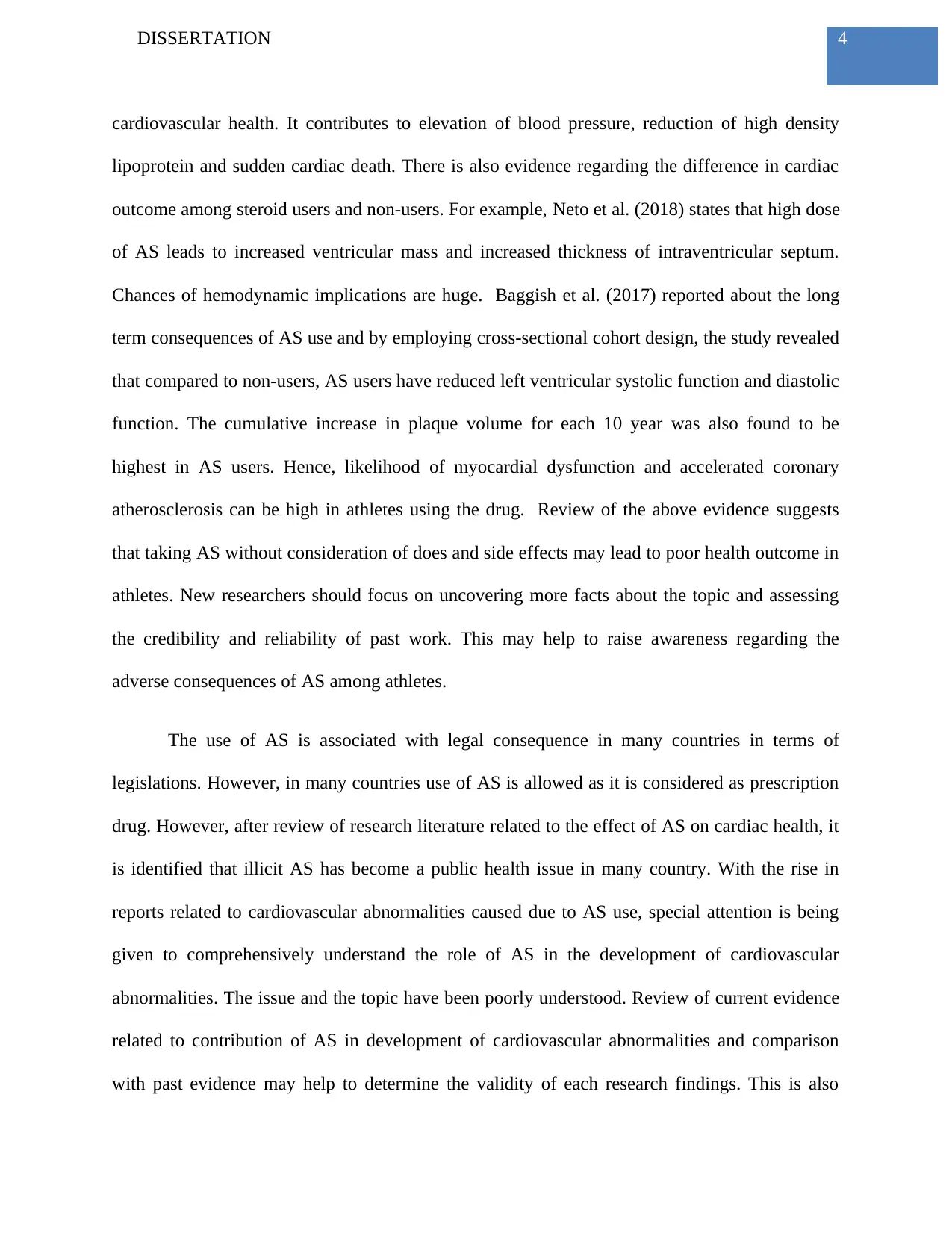
4DISSERTATION
cardiovascular health. It contributes to elevation of blood pressure, reduction of high density
lipoprotein and sudden cardiac death. There is also evidence regarding the difference in cardiac
outcome among steroid users and non-users. For example, Neto et al. (2018) states that high dose
of AS leads to increased ventricular mass and increased thickness of intraventricular septum.
Chances of hemodynamic implications are huge. Baggish et al. (2017) reported about the long
term consequences of AS use and by employing cross-sectional cohort design, the study revealed
that compared to non-users, AS users have reduced left ventricular systolic function and diastolic
function. The cumulative increase in plaque volume for each 10 year was also found to be
highest in AS users. Hence, likelihood of myocardial dysfunction and accelerated coronary
atherosclerosis can be high in athletes using the drug. Review of the above evidence suggests
that taking AS without consideration of does and side effects may lead to poor health outcome in
athletes. New researchers should focus on uncovering more facts about the topic and assessing
the credibility and reliability of past work. This may help to raise awareness regarding the
adverse consequences of AS among athletes.
The use of AS is associated with legal consequence in many countries in terms of
legislations. However, in many countries use of AS is allowed as it is considered as prescription
drug. However, after review of research literature related to the effect of AS on cardiac health, it
is identified that illicit AS has become a public health issue in many country. With the rise in
reports related to cardiovascular abnormalities caused due to AS use, special attention is being
given to comprehensively understand the role of AS in the development of cardiovascular
abnormalities. The issue and the topic have been poorly understood. Review of current evidence
related to contribution of AS in development of cardiovascular abnormalities and comparison
with past evidence may help to determine the validity of each research findings. This is also
cardiovascular health. It contributes to elevation of blood pressure, reduction of high density
lipoprotein and sudden cardiac death. There is also evidence regarding the difference in cardiac
outcome among steroid users and non-users. For example, Neto et al. (2018) states that high dose
of AS leads to increased ventricular mass and increased thickness of intraventricular septum.
Chances of hemodynamic implications are huge. Baggish et al. (2017) reported about the long
term consequences of AS use and by employing cross-sectional cohort design, the study revealed
that compared to non-users, AS users have reduced left ventricular systolic function and diastolic
function. The cumulative increase in plaque volume for each 10 year was also found to be
highest in AS users. Hence, likelihood of myocardial dysfunction and accelerated coronary
atherosclerosis can be high in athletes using the drug. Review of the above evidence suggests
that taking AS without consideration of does and side effects may lead to poor health outcome in
athletes. New researchers should focus on uncovering more facts about the topic and assessing
the credibility and reliability of past work. This may help to raise awareness regarding the
adverse consequences of AS among athletes.
The use of AS is associated with legal consequence in many countries in terms of
legislations. However, in many countries use of AS is allowed as it is considered as prescription
drug. However, after review of research literature related to the effect of AS on cardiac health, it
is identified that illicit AS has become a public health issue in many country. With the rise in
reports related to cardiovascular abnormalities caused due to AS use, special attention is being
given to comprehensively understand the role of AS in the development of cardiovascular
abnormalities. The issue and the topic have been poorly understood. Review of current evidence
related to contribution of AS in development of cardiovascular abnormalities and comparison
with past evidence may help to determine the validity of each research findings. This is also
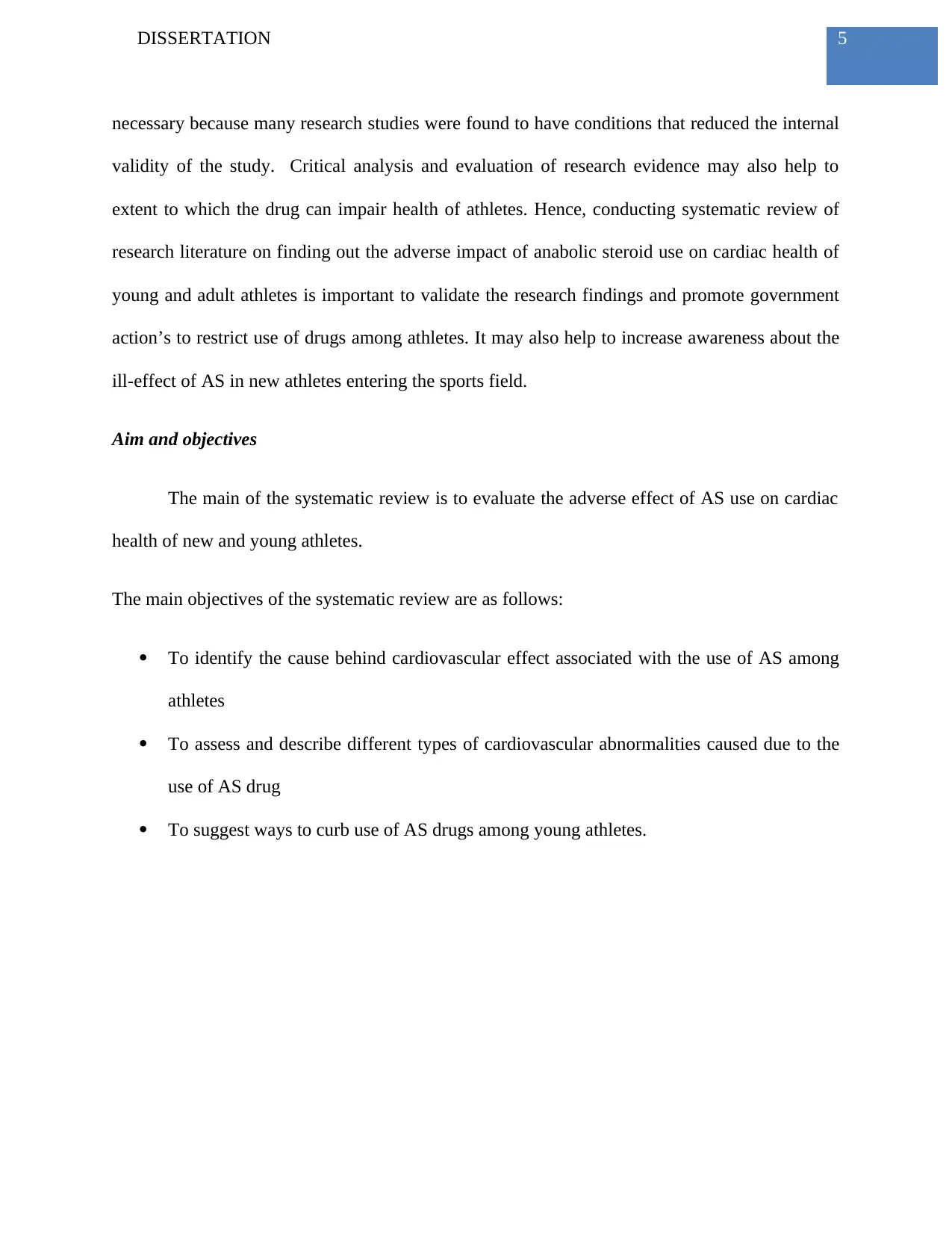
5DISSERTATION
necessary because many research studies were found to have conditions that reduced the internal
validity of the study. Critical analysis and evaluation of research evidence may also help to
extent to which the drug can impair health of athletes. Hence, conducting systematic review of
research literature on finding out the adverse impact of anabolic steroid use on cardiac health of
young and adult athletes is important to validate the research findings and promote government
action’s to restrict use of drugs among athletes. It may also help to increase awareness about the
ill-effect of AS in new athletes entering the sports field.
Aim and objectives
The main of the systematic review is to evaluate the adverse effect of AS use on cardiac
health of new and young athletes.
The main objectives of the systematic review are as follows:
To identify the cause behind cardiovascular effect associated with the use of AS among
athletes
To assess and describe different types of cardiovascular abnormalities caused due to the
use of AS drug
To suggest ways to curb use of AS drugs among young athletes.
necessary because many research studies were found to have conditions that reduced the internal
validity of the study. Critical analysis and evaluation of research evidence may also help to
extent to which the drug can impair health of athletes. Hence, conducting systematic review of
research literature on finding out the adverse impact of anabolic steroid use on cardiac health of
young and adult athletes is important to validate the research findings and promote government
action’s to restrict use of drugs among athletes. It may also help to increase awareness about the
ill-effect of AS in new athletes entering the sports field.
Aim and objectives
The main of the systematic review is to evaluate the adverse effect of AS use on cardiac
health of new and young athletes.
The main objectives of the systematic review are as follows:
To identify the cause behind cardiovascular effect associated with the use of AS among
athletes
To assess and describe different types of cardiovascular abnormalities caused due to the
use of AS drug
To suggest ways to curb use of AS drugs among young athletes.
⊘ This is a preview!⊘
Do you want full access?
Subscribe today to unlock all pages.

Trusted by 1+ million students worldwide
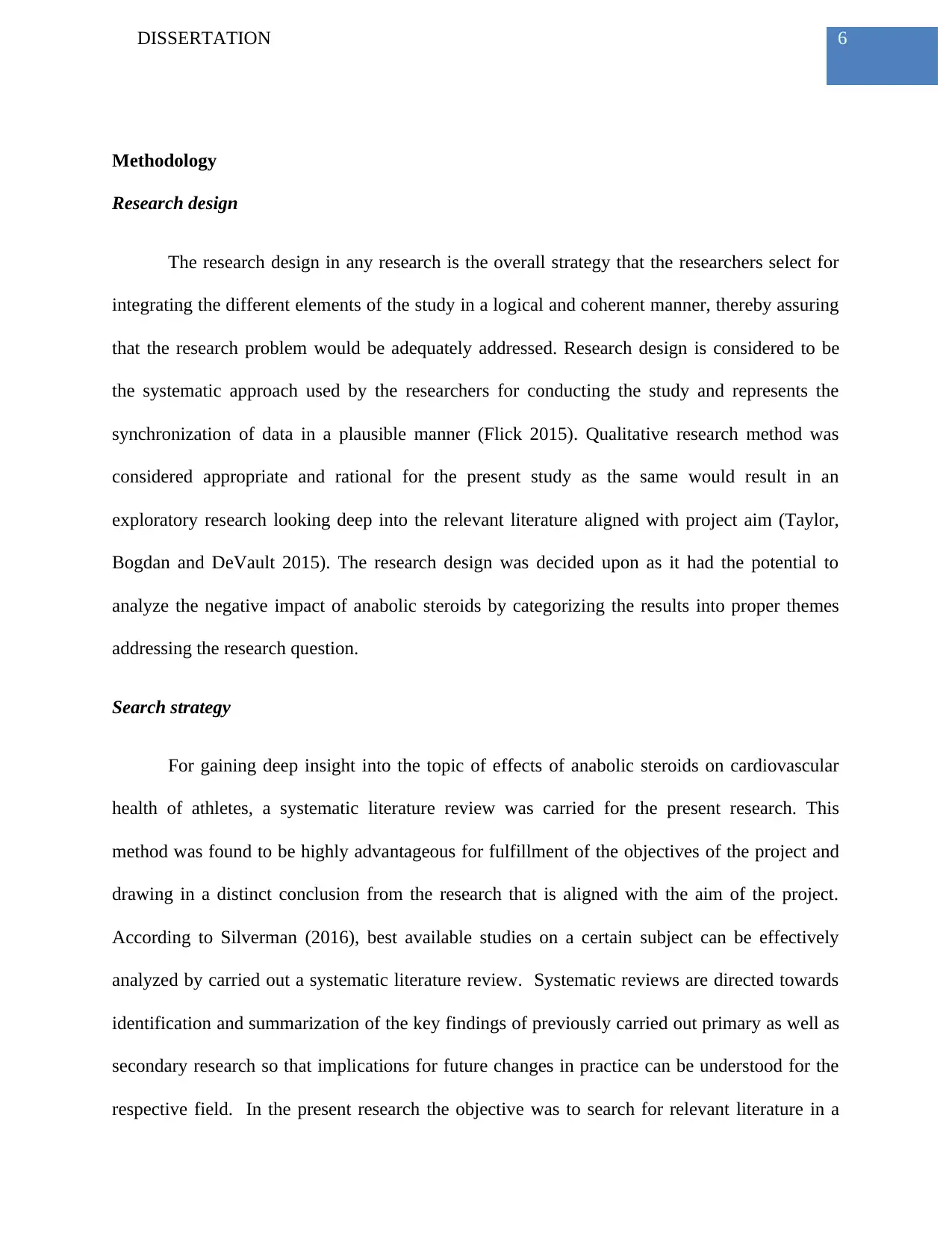
6DISSERTATION
Methodology
Research design
The research design in any research is the overall strategy that the researchers select for
integrating the different elements of the study in a logical and coherent manner, thereby assuring
that the research problem would be adequately addressed. Research design is considered to be
the systematic approach used by the researchers for conducting the study and represents the
synchronization of data in a plausible manner (Flick 2015). Qualitative research method was
considered appropriate and rational for the present study as the same would result in an
exploratory research looking deep into the relevant literature aligned with project aim (Taylor,
Bogdan and DeVault 2015). The research design was decided upon as it had the potential to
analyze the negative impact of anabolic steroids by categorizing the results into proper themes
addressing the research question.
Search strategy
For gaining deep insight into the topic of effects of anabolic steroids on cardiovascular
health of athletes, a systematic literature review was carried for the present research. This
method was found to be highly advantageous for fulfillment of the objectives of the project and
drawing in a distinct conclusion from the research that is aligned with the aim of the project.
According to Silverman (2016), best available studies on a certain subject can be effectively
analyzed by carried out a systematic literature review. Systematic reviews are directed towards
identification and summarization of the key findings of previously carried out primary as well as
secondary research so that implications for future changes in practice can be understood for the
respective field. In the present research the objective was to search for relevant literature in a
Methodology
Research design
The research design in any research is the overall strategy that the researchers select for
integrating the different elements of the study in a logical and coherent manner, thereby assuring
that the research problem would be adequately addressed. Research design is considered to be
the systematic approach used by the researchers for conducting the study and represents the
synchronization of data in a plausible manner (Flick 2015). Qualitative research method was
considered appropriate and rational for the present study as the same would result in an
exploratory research looking deep into the relevant literature aligned with project aim (Taylor,
Bogdan and DeVault 2015). The research design was decided upon as it had the potential to
analyze the negative impact of anabolic steroids by categorizing the results into proper themes
addressing the research question.
Search strategy
For gaining deep insight into the topic of effects of anabolic steroids on cardiovascular
health of athletes, a systematic literature review was carried for the present research. This
method was found to be highly advantageous for fulfillment of the objectives of the project and
drawing in a distinct conclusion from the research that is aligned with the aim of the project.
According to Silverman (2016), best available studies on a certain subject can be effectively
analyzed by carried out a systematic literature review. Systematic reviews are directed towards
identification and summarization of the key findings of previously carried out primary as well as
secondary research so that implications for future changes in practice can be understood for the
respective field. In the present research the objective was to search for relevant literature in a
Paraphrase This Document
Need a fresh take? Get an instant paraphrase of this document with our AI Paraphraser
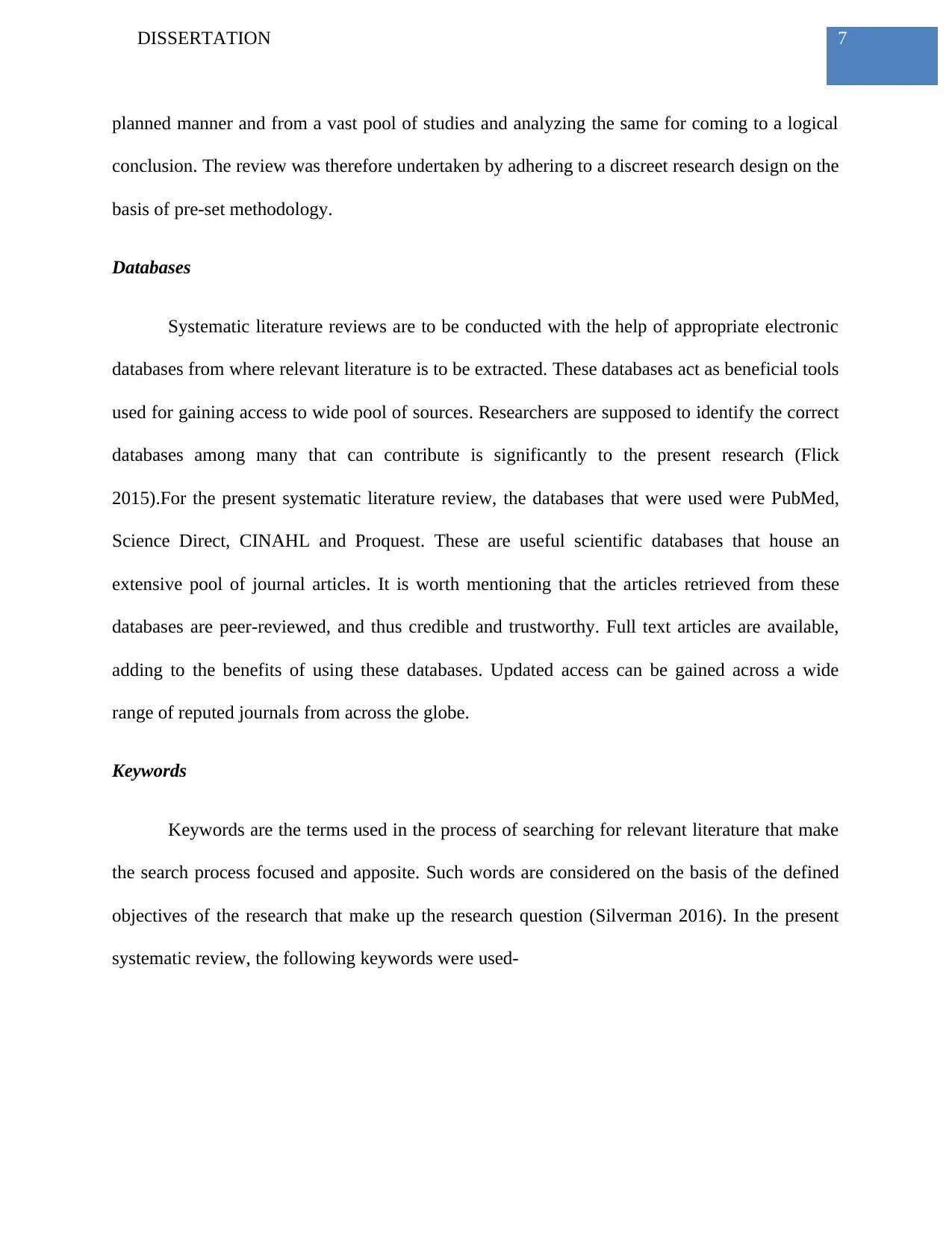
7DISSERTATION
planned manner and from a vast pool of studies and analyzing the same for coming to a logical
conclusion. The review was therefore undertaken by adhering to a discreet research design on the
basis of pre-set methodology.
Databases
Systematic literature reviews are to be conducted with the help of appropriate electronic
databases from where relevant literature is to be extracted. These databases act as beneficial tools
used for gaining access to wide pool of sources. Researchers are supposed to identify the correct
databases among many that can contribute is significantly to the present research (Flick
2015).For the present systematic literature review, the databases that were used were PubMed,
Science Direct, CINAHL and Proquest. These are useful scientific databases that house an
extensive pool of journal articles. It is worth mentioning that the articles retrieved from these
databases are peer-reviewed, and thus credible and trustworthy. Full text articles are available,
adding to the benefits of using these databases. Updated access can be gained across a wide
range of reputed journals from across the globe.
Keywords
Keywords are the terms used in the process of searching for relevant literature that make
the search process focused and apposite. Such words are considered on the basis of the defined
objectives of the research that make up the research question (Silverman 2016). In the present
systematic review, the following keywords were used-
planned manner and from a vast pool of studies and analyzing the same for coming to a logical
conclusion. The review was therefore undertaken by adhering to a discreet research design on the
basis of pre-set methodology.
Databases
Systematic literature reviews are to be conducted with the help of appropriate electronic
databases from where relevant literature is to be extracted. These databases act as beneficial tools
used for gaining access to wide pool of sources. Researchers are supposed to identify the correct
databases among many that can contribute is significantly to the present research (Flick
2015).For the present systematic literature review, the databases that were used were PubMed,
Science Direct, CINAHL and Proquest. These are useful scientific databases that house an
extensive pool of journal articles. It is worth mentioning that the articles retrieved from these
databases are peer-reviewed, and thus credible and trustworthy. Full text articles are available,
adding to the benefits of using these databases. Updated access can be gained across a wide
range of reputed journals from across the globe.
Keywords
Keywords are the terms used in the process of searching for relevant literature that make
the search process focused and apposite. Such words are considered on the basis of the defined
objectives of the research that make up the research question (Silverman 2016). In the present
systematic review, the following keywords were used-
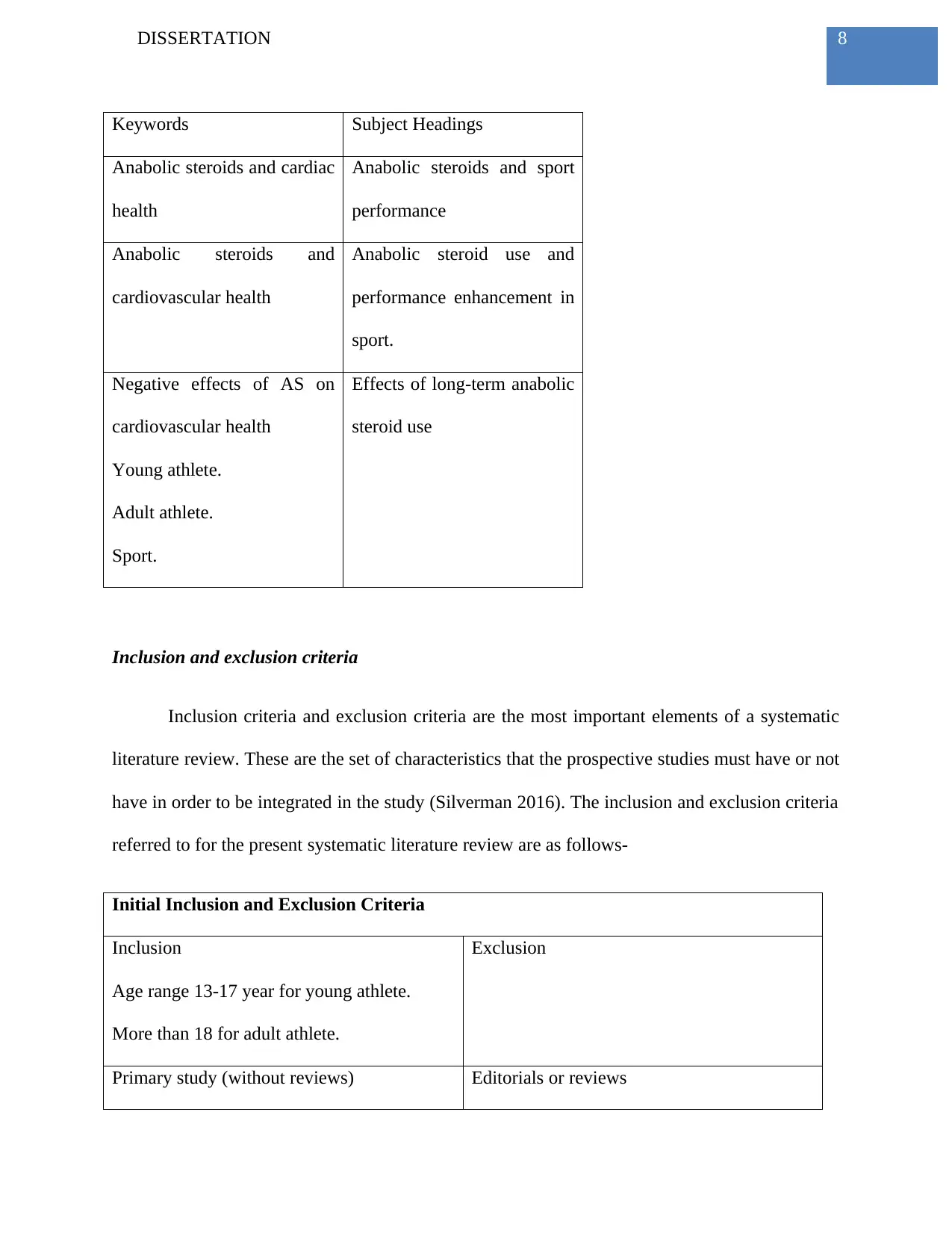
8DISSERTATION
Keywords Subject Headings
Anabolic steroids and cardiac
health
Anabolic steroids and sport
performance
Anabolic steroids and
cardiovascular health
Anabolic steroid use and
performance enhancement in
sport.
Negative effects of AS on
cardiovascular health
Young athlete.
Adult athlete.
Sport.
Effects of long-term anabolic
steroid use
Inclusion and exclusion criteria
Inclusion criteria and exclusion criteria are the most important elements of a systematic
literature review. These are the set of characteristics that the prospective studies must have or not
have in order to be integrated in the study (Silverman 2016). The inclusion and exclusion criteria
referred to for the present systematic literature review are as follows-
Initial Inclusion and Exclusion Criteria
Inclusion
Age range 13-17 year for young athlete.
More than 18 for adult athlete.
Exclusion
Primary study (without reviews) Editorials or reviews
Keywords Subject Headings
Anabolic steroids and cardiac
health
Anabolic steroids and sport
performance
Anabolic steroids and
cardiovascular health
Anabolic steroid use and
performance enhancement in
sport.
Negative effects of AS on
cardiovascular health
Young athlete.
Adult athlete.
Sport.
Effects of long-term anabolic
steroid use
Inclusion and exclusion criteria
Inclusion criteria and exclusion criteria are the most important elements of a systematic
literature review. These are the set of characteristics that the prospective studies must have or not
have in order to be integrated in the study (Silverman 2016). The inclusion and exclusion criteria
referred to for the present systematic literature review are as follows-
Initial Inclusion and Exclusion Criteria
Inclusion
Age range 13-17 year for young athlete.
More than 18 for adult athlete.
Exclusion
Primary study (without reviews) Editorials or reviews
⊘ This is a preview!⊘
Do you want full access?
Subscribe today to unlock all pages.

Trusted by 1+ million students worldwide
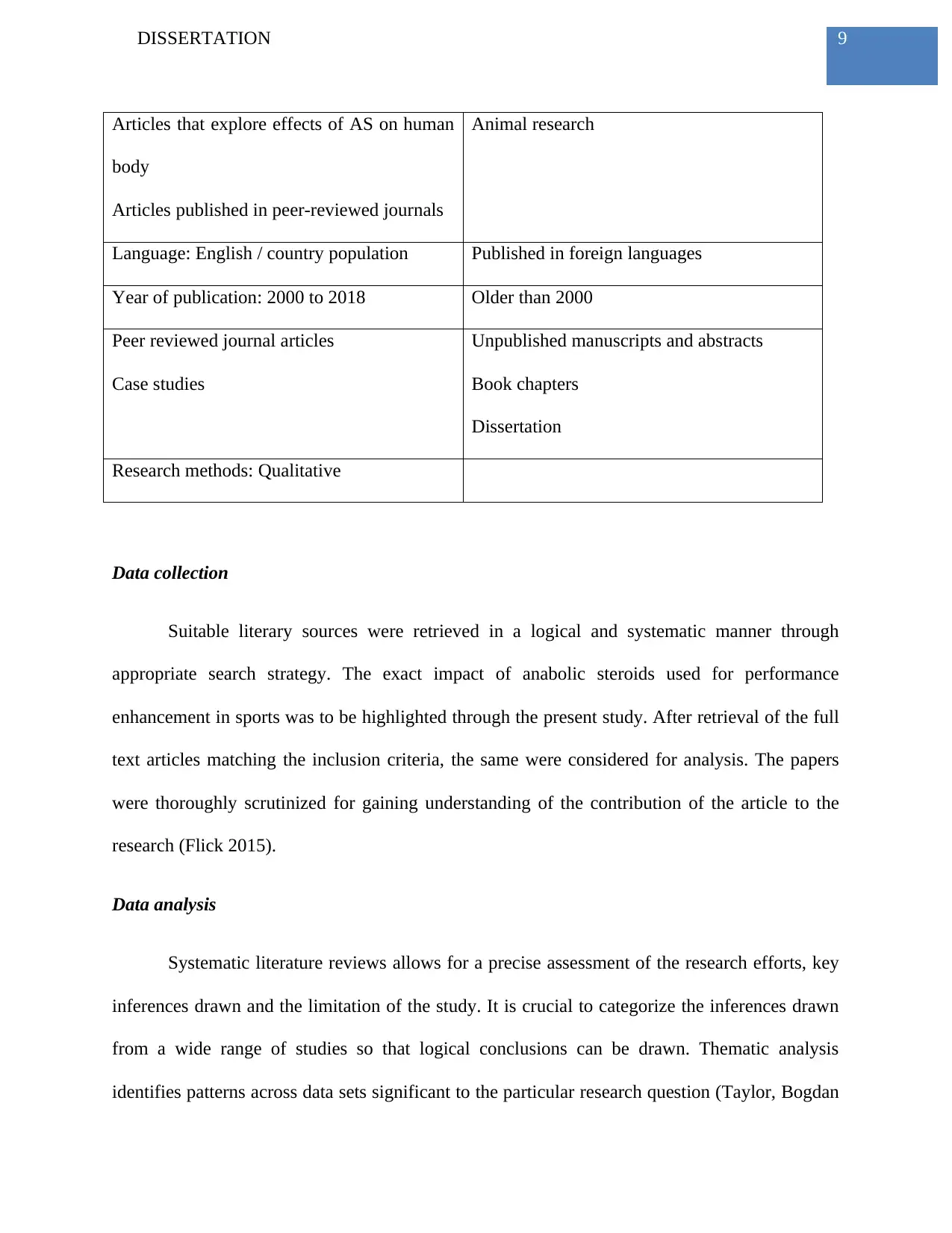
9DISSERTATION
Articles that explore effects of AS on human
body
Articles published in peer-reviewed journals
Animal research
Language: English / country population Published in foreign languages
Year of publication: 2000 to 2018 Older than 2000
Peer reviewed journal articles
Case studies
Unpublished manuscripts and abstracts
Book chapters
Dissertation
Research methods: Qualitative
Data collection
Suitable literary sources were retrieved in a logical and systematic manner through
appropriate search strategy. The exact impact of anabolic steroids used for performance
enhancement in sports was to be highlighted through the present study. After retrieval of the full
text articles matching the inclusion criteria, the same were considered for analysis. The papers
were thoroughly scrutinized for gaining understanding of the contribution of the article to the
research (Flick 2015).
Data analysis
Systematic literature reviews allows for a precise assessment of the research efforts, key
inferences drawn and the limitation of the study. It is crucial to categorize the inferences drawn
from a wide range of studies so that logical conclusions can be drawn. Thematic analysis
identifies patterns across data sets significant to the particular research question (Taylor, Bogdan
Articles that explore effects of AS on human
body
Articles published in peer-reviewed journals
Animal research
Language: English / country population Published in foreign languages
Year of publication: 2000 to 2018 Older than 2000
Peer reviewed journal articles
Case studies
Unpublished manuscripts and abstracts
Book chapters
Dissertation
Research methods: Qualitative
Data collection
Suitable literary sources were retrieved in a logical and systematic manner through
appropriate search strategy. The exact impact of anabolic steroids used for performance
enhancement in sports was to be highlighted through the present study. After retrieval of the full
text articles matching the inclusion criteria, the same were considered for analysis. The papers
were thoroughly scrutinized for gaining understanding of the contribution of the article to the
research (Flick 2015).
Data analysis
Systematic literature reviews allows for a precise assessment of the research efforts, key
inferences drawn and the limitation of the study. It is crucial to categorize the inferences drawn
from a wide range of studies so that logical conclusions can be drawn. Thematic analysis
identifies patterns across data sets significant to the particular research question (Taylor, Bogdan
Paraphrase This Document
Need a fresh take? Get an instant paraphrase of this document with our AI Paraphraser
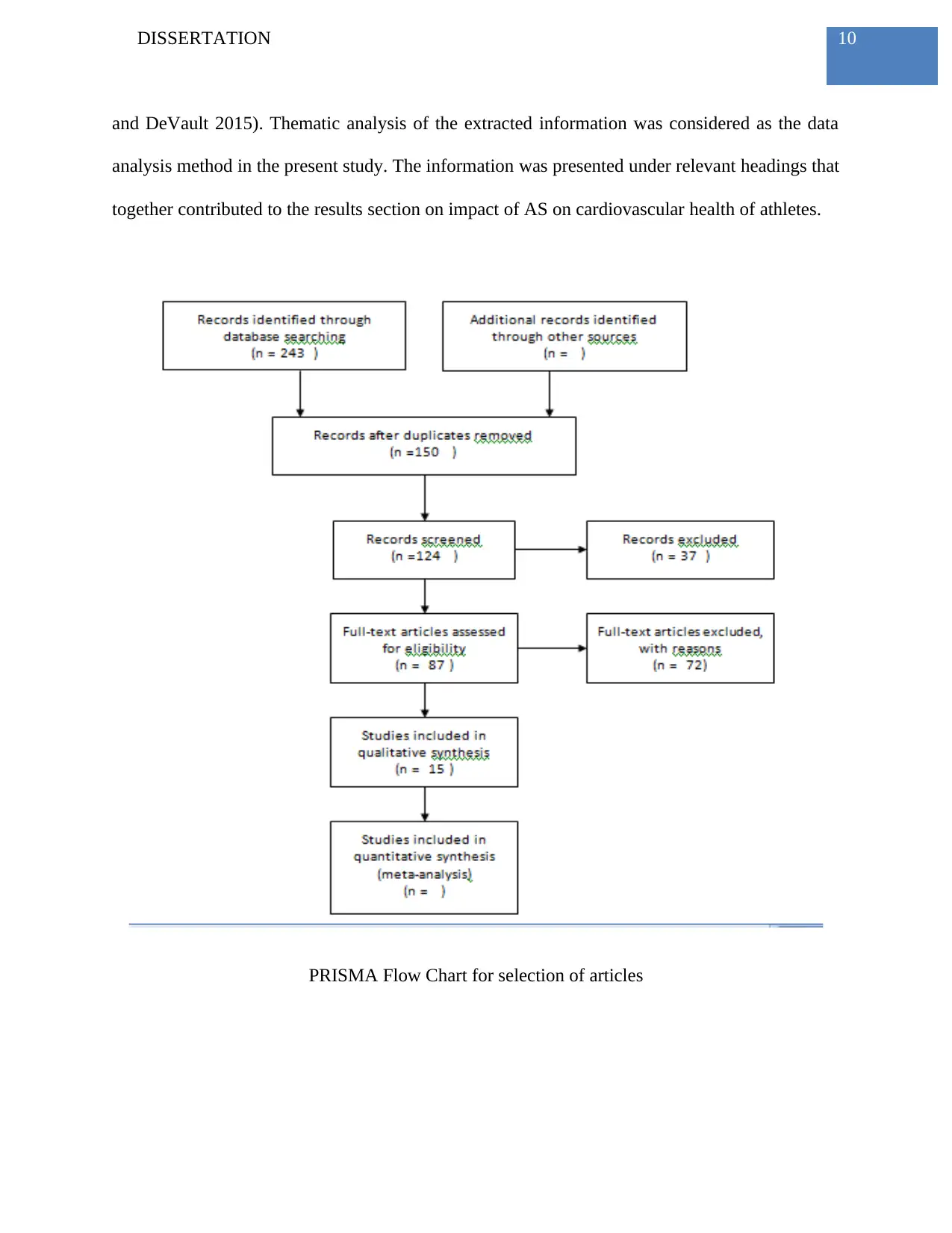
10DISSERTATION
and DeVault 2015). Thematic analysis of the extracted information was considered as the data
analysis method in the present study. The information was presented under relevant headings that
together contributed to the results section on impact of AS on cardiovascular health of athletes.
PRISMA Flow Chart for selection of articles
and DeVault 2015). Thematic analysis of the extracted information was considered as the data
analysis method in the present study. The information was presented under relevant headings that
together contributed to the results section on impact of AS on cardiovascular health of athletes.
PRISMA Flow Chart for selection of articles
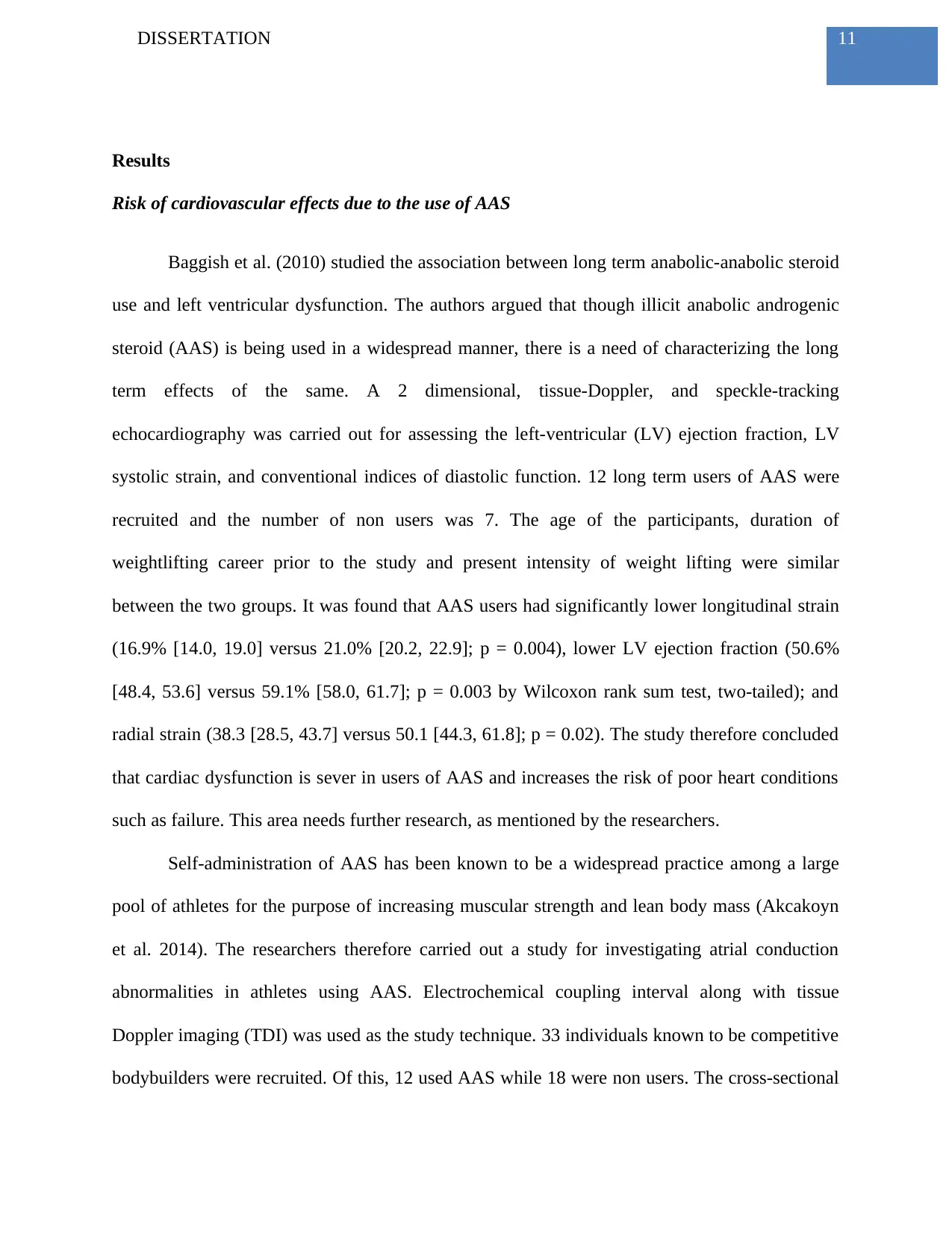
11DISSERTATION
Results
Risk of cardiovascular effects due to the use of AAS
Baggish et al. (2010) studied the association between long term anabolic-anabolic steroid
use and left ventricular dysfunction. The authors argued that though illicit anabolic androgenic
steroid (AAS) is being used in a widespread manner, there is a need of characterizing the long
term effects of the same. A 2 dimensional, tissue-Doppler, and speckle-tracking
echocardiography was carried out for assessing the left-ventricular (LV) ejection fraction, LV
systolic strain, and conventional indices of diastolic function. 12 long term users of AAS were
recruited and the number of non users was 7. The age of the participants, duration of
weightlifting career prior to the study and present intensity of weight lifting were similar
between the two groups. It was found that AAS users had significantly lower longitudinal strain
(16.9% [14.0, 19.0] versus 21.0% [20.2, 22.9]; p = 0.004), lower LV ejection fraction (50.6%
[48.4, 53.6] versus 59.1% [58.0, 61.7]; p = 0.003 by Wilcoxon rank sum test, two-tailed); and
radial strain (38.3 [28.5, 43.7] versus 50.1 [44.3, 61.8]; p = 0.02). The study therefore concluded
that cardiac dysfunction is sever in users of AAS and increases the risk of poor heart conditions
such as failure. This area needs further research, as mentioned by the researchers.
Self-administration of AAS has been known to be a widespread practice among a large
pool of athletes for the purpose of increasing muscular strength and lean body mass (Akcakoyn
et al. 2014). The researchers therefore carried out a study for investigating atrial conduction
abnormalities in athletes using AAS. Electrochemical coupling interval along with tissue
Doppler imaging (TDI) was used as the study technique. 33 individuals known to be competitive
bodybuilders were recruited. Of this, 12 used AAS while 18 were non users. The cross-sectional
Results
Risk of cardiovascular effects due to the use of AAS
Baggish et al. (2010) studied the association between long term anabolic-anabolic steroid
use and left ventricular dysfunction. The authors argued that though illicit anabolic androgenic
steroid (AAS) is being used in a widespread manner, there is a need of characterizing the long
term effects of the same. A 2 dimensional, tissue-Doppler, and speckle-tracking
echocardiography was carried out for assessing the left-ventricular (LV) ejection fraction, LV
systolic strain, and conventional indices of diastolic function. 12 long term users of AAS were
recruited and the number of non users was 7. The age of the participants, duration of
weightlifting career prior to the study and present intensity of weight lifting were similar
between the two groups. It was found that AAS users had significantly lower longitudinal strain
(16.9% [14.0, 19.0] versus 21.0% [20.2, 22.9]; p = 0.004), lower LV ejection fraction (50.6%
[48.4, 53.6] versus 59.1% [58.0, 61.7]; p = 0.003 by Wilcoxon rank sum test, two-tailed); and
radial strain (38.3 [28.5, 43.7] versus 50.1 [44.3, 61.8]; p = 0.02). The study therefore concluded
that cardiac dysfunction is sever in users of AAS and increases the risk of poor heart conditions
such as failure. This area needs further research, as mentioned by the researchers.
Self-administration of AAS has been known to be a widespread practice among a large
pool of athletes for the purpose of increasing muscular strength and lean body mass (Akcakoyn
et al. 2014). The researchers therefore carried out a study for investigating atrial conduction
abnormalities in athletes using AAS. Electrochemical coupling interval along with tissue
Doppler imaging (TDI) was used as the study technique. 33 individuals known to be competitive
bodybuilders were recruited. Of this, 12 used AAS while 18 were non users. The cross-sectional
⊘ This is a preview!⊘
Do you want full access?
Subscribe today to unlock all pages.

Trusted by 1+ million students worldwide
1 out of 28
Related Documents
Your All-in-One AI-Powered Toolkit for Academic Success.
+13062052269
info@desklib.com
Available 24*7 on WhatsApp / Email
![[object Object]](/_next/static/media/star-bottom.7253800d.svg)
Unlock your academic potential
Copyright © 2020–2025 A2Z Services. All Rights Reserved. Developed and managed by ZUCOL.





